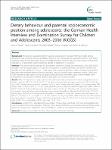Dietary behaviour and parental socioeconomic position among adolescents: the German Health Interview and Examination Survey for Children and Adolescents 2003–2006 (KiGGS)
Finger, Jonas
Varnaccia, Gianni
Tylleskär, Thorkild
Lampert, Thomas
Mensink, Gert
Background: The positive association between parental socioeconomic position (PSEP) and health among adolescents may be partly explained by dietary behaviour. We investigated the associations between fruit intake, vegetable intake, energy-dense food intake, the Healthy Nutrition Score for Kids and Youth (HuSKY) and parental education in a nationwide, cluster-randomized sample of adolescents in Germany. Methods: The German Health Interview and Examination Survey for Children and Adolescents 2003–2006 (KiGGS) included 17,641 individuals aged 0–17 years and their parents. Complete information on relevant variables was available for 6359 individuals in the 11–17 age group. The associations between nutrition indicators and parental education were analysed separately for boys and girls, using multivariate logistic regression analysis. Odds ratios (ORs) adjusted for age, region, income, occupation, physical activity and weight status related variables, were calculated for the associations between parental education and nutrition indicators. Results: After full adjustment, higher parental education level was associated with lower energy-dense food intake – with an OR of 1.3 (95 % CI 1.0–1.7) for boys with secondary educated parents and 1.8 (1.4–2.3) for boys with tertiary educated parents compared to boys with primary educated parents; the corresponding ORs for girls were 1.2 (0.9–1.5) and 1.6 (1.2–2.2). Higher parental education was associated with higher fruit intake – with an OR of 1.3 (1.0–1.7) for boys with secondary educated parents and 2.0 (1.5–2.7) for boys with tertiary educated parents compared to boys with primary educated parents; the corresponding ORs for girls were 1.0 (0.8–1.4) and 1.5 (1.0–2.1). Among boys and girls with tertiary educated parents compared to those with primary educated parents an OR of 1.3 (CI boys: 1.0–1.7, CI girls: 1.0–1.6) was observed for high vegetable intake. Among boys with tertiary educated parents compared to boys with primary educated parents an OR of 1.6 (1.2–2.2) was observed for a high HuSKY; the corresponding OR for girls was 1.5 (1.1–1.9). Conclusions: A high PSEP is associated with consumption of less energy-dense food, more fruits and vegetables and more favourable overall dietary behaviour. Preferably school-based interventions are needed to promote healthy dietary behaviour among German adolescents and a special effort is needed to reach adolescents from low-PSEP families.
Dateien zu dieser Publikation
Keine Lizenzangabe

